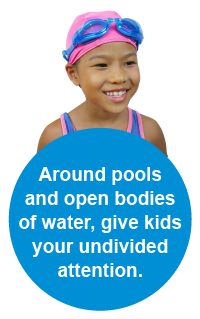SWIMMING
 Here you’ll find everything you need to know about swimming safety. Whether it’s a trip to the beach or a dip in the community or backyard pool, you can ensure that swimming is as safe as it is fun by following a few basic safety tips.
Here you’ll find everything you need to know about swimming safety. Whether it’s a trip to the beach or a dip in the community or backyard pool, you can ensure that swimming is as safe as it is fun by following a few basic safety tips.
Hard Facts about Swimming Safety
- Among preventable injuries, drowning is the leading cause of death for children 1 – 4 years old.
- Children 1 – 4 years old are more likely to drown in a pool.
- Children 5 years and older are more likely to drown in natural water, such as ponds, lakes and rivers.
- The risk of drowning in open water increases with age: The average 10-year-old, for example, is three times more likely to drown in open water than in a pool.
Top Tips about Swimming Safety
- Watch kids when they are in or around water, without being distracted. Keep young children within arm’s reach of an adult. Make sure older children swim with a partner every time.
- Teach children how to swim. Every child is different, so enroll children in swim lessons when they are ready. Consider their age, development and how often they are around water when deciding if they are ready for swim lessons.
- Make sure kids learn these five water survival skills and that they are able to:
- step or jump into water over their heads and return to the surface;
- float or tread water for one minute;
- turn around in a full circle and find an exit;
- swim 25 yards to exit the water; and
- exit the water. If in a pool, be able to exit without using the ladder
- Teach children that swimming in open water is not the same as swimming in a pool. They need to be aware of uneven surfaces, river currents, ocean undertow and changing weather.
- Know what to do in an emergency. Learning CPR and basic water rescue skills may help you save a child’s life.
Learn More
Don’t worry – you’re not in over your head in terms of swimming safety. But if you’re interested, here’s some more information on how to keep your family safe in and around water.
